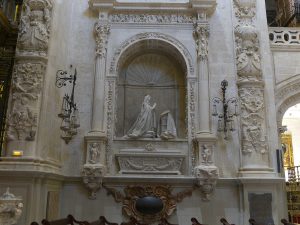
It is no exaggeration to say that in the eight centuries since the birth of King Alfonso X, his scientific patronage is what has brought him most recognition. The king’s work went beyond mere patronage – something already undertaken by his father Ferdinand III – because Alfonso surrounded himself with a large group of competent intellectuals and assumed leadership and direction over the activities to be carried out. The fruit of all this effort were some 30 treatises of a (more or less) scientific nature, some of them translations and some of them own production.
The most precious jewel produced by the royal patronage were the so-called Alfonsine Tables. Unfortunately, no copies of the original Spanish version of the Tables have survived, with the exception of the Canons. Of this series of treatises, which explain how to use the Tables, a very late copy is preserved in the manuscript Ms. 3306 of the Biblioteca Nacional, dated at the beginning of the 16th century. Translations of the Tables themselves are preserved in quite a number of manuscripts preserved in different European libraries, and also in the many printings that were made after the development of the printing press. But the lack of the original Castilian and the discrepancies between the preserved versions make the Alfonsine Tables a rather more nebulous object than the precision of their name would seem to indicate.
The Canons explain that the Tables were made in Toledo between 1262 and 1272 by two of the king’s collaborators, the Jews Judah ben Moses ha-Cohen and Isaac ben Sid. Judah ben Moses was also a physician, had previously worked for Ferdinand III and contributed to the translation commissioned by Alfonso X of a number of astronomical and astrological works. Isaac ben Sid was the most prolific scientific collaborator of the wise king, with numerous works, mostly his own but also translated, on the construction of astronomical instruments and clocks.

The Tables were an improvement on the so-called Toledo Tables of Azarquiel, the best of the astronomers who flourished in Al-Andalus. Alfonso X’s purpose in ordering new tables was to improve the accuracy of the Toledo Tables.
The Alfonsine Tables, properly speaking, contained diverse information on the positions of the planets, and conjunctions between them – including the Sun and the Moon – referred to the latitude of Toledo.
In almost any history of astronomy that considers them, there is no shortage of praise for the importance of the Alfonsine Tables. Thus, in Dreyer’s now venerable A history of astronomy, from Thales to Kepler, we can read: “New planetary tables had long been considered a necessity, and this important task was finally taken up by King Alfonso X of Castile and several Jewish and Christian astronomers working for him in Toledo, who prepared the celebrated Alfonsine Tables. Highly reputed, they were regarded for the next three hundred years as the best planetary tables”. Or in the more recent, From Eudoxus to Einstein, a history of mathematical astronomy, by Linton, where we read: “As far as the history of astronomy is concerned, one of the most significant events of the Middle Ages occurred in 13th century Spain. The Christian king Alfonso X (the Wise) ruled the kingdoms of León and Castile from 1252 to 1284, and established and presided over a group of astronomers, predominantly Christian and Jewish, charged with translating astronomical texts into the Castilian language. The most important product of this enterprise was a set of astronomical tables. The original text of the Alfonsine Tables has been lost, but it is widely accepted that they were written in Toledo around 1270 to replace other tables produced there in the 11th century. The Tables circulated in many versions (in Latin translations) and formed the basis of virtually all astronomical calculations until the mid-17th century”. Or in the edition of (part) of the Canons by J. Chabás and B. R. Goldstein, where we read: “The impact of the Alfonsine Tables on the development of European astronomy from the 13th to the middle of the 16th century was enormous, and is the reason why Alfonso X is remembered”. And further on: “It was the making of the Tables that gave King Alfonso his most lasting asset to enter history”.
The Alfonsine Tables were revamped in the mid-15th century by Georg Peurbach (1423-1462) and his disciple Johannes Müller (1436-1476) – better known as Regiomontanus – and eventually replaced by the much more accurate Rudolfine Tables, drawn up by Kepler with the excellent observations that Tycho Brahe (1546-1601) made on the island of Hven during the last quarter of the 16th century.

As has been said, no Castilian copy of the Alfonsine Tables has been preserved, but the Latin versions are abundant, as they soon spread throughout Europe -adapted to the latitude of various European cities-. They remained in use until the 17th century and were the basis of astronomical calculations made during the 14th to 16th centuries. They were first printed in Venice in 1483; the printer, Erhard Ratdolt, had printed Euclid’s Elements the previous year. They were reprinted in Venice in 1492, in 1518, in 1524, and in Paris in 1545 and 1553, which gives a good idea of the interest they still had in the mid-16th century.

Leave a Reply